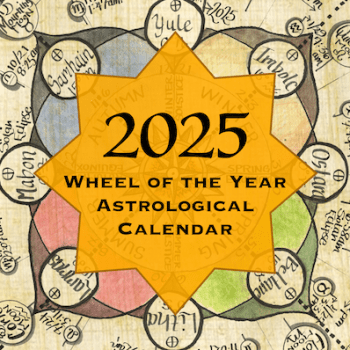It has long been speculated the Valentine’s Day emerged from Lupercalia. While there are no definitive links, there are some striking similarities between the two.

In this article, I wanted to dig deeper into both. Despite Roman ancestry, I don’t officially celebrate either of these days. For one, blood sacrifices are generally frowned upon, and I’m typically quite fond of my dogs.
For Valentine’s Day, the commercialization never sat right with my desire to be free of societal pressures. I prefer to show and be shown love and appreciation through daily acts rather than on an assigned day. That said, these are my personal preferences which have no bearing on others.
Instead, this article is to open the conversation and provide ideas. While this isn’t one of the official eight sabbats, many pagans do choose to celebrate this time of year, and I do tend to enjoy cause for celebration. As such, I will present some of the origins of these festivities and ways this practice can be brought to life in modern times.
Lupercalia
Lupercalia, an ancient pagan festival, was held annually on February 15th in Rome and can be traced back to 6 BCE. This celebration was held near Palatine Hill in Rome, and the ceremony took place at the Lupercal cave. This cave was chosen because, in Roman mythology, this was the cave where Romulus and Remus, the founders of Rome, were nourished by the she-wolf.
On this day, Luperci, a group of Roman priests, would sacrifice a goat—and a dog—during this ceremony. The sacrificial knife was dipped in blood and smeared on the foreheads of two of the chosen, naked men. The blood was then wiped off with wool dipped in milk. A sacrificial feast followed this portion of the festivities.
Afterward, the goat’s hide would be fashioned into whips, and the men would run around unclothed and lash the women. However, getting struck by these whips wasn’t an unsavory occurrence. In fact, it was considered quite fortunate as it was thought to bring fertility to the recipients. Many festival goers would purposefully place themselves in front of the whips to ensure fertility.
This celebration was honored for hundreds of years but outlawed by Pope Gelasius in 494 CE. According to National Geographic, Lupercalia was “one of the few pagan holidays still celebrated 150 years after Christianity was legalized in the Roman Empire.” Which isn’t a small feat by any means.
Valentine’s Day
It wasn’t long after Pope Gelasius put an end to Lupercalia that the Catholic Church appointed February 14th as a holiday to celebrate Saint Valentine.
There are a few possible namesakes for Valentine’s Day. Most are presumed to have been executed, and two of them were executed on February 14th, according to NPR’s article, “The Dark Origins of Valentine’s Day.” One of these men was thought to marry individuals in secrecy. As such, Saint Valentine evolved and became the “Patron of Lovers,” which led to the holiday we know today.
So what do Lupercalia and Valentine’s Day have in common? Well, perhaps nothing, but as stated initially, there are similarities. The most obvious is that the occur within 24 hours of one another. A little suspicious, sure, but nothing concrete. Another similarity is the use of red (blood) and white (milk) in both festivities.
There is another potential similarity. While it’s debated by some modern scholars, it was believed by others that there was a matchmaking lottery associated with the Lupercalia festival. During this time, men would draw women’s names from a hat, and the two would pair up for the duration of the festivities. This would follow suit with some modern-day matchmaking and romantic elements of this holiday.
Celebrating Lupercalia in Modern Times
While animal sacrifice and running the streets naked would likely result in an arrest these days, we can still get into some other good-natured debauchery if we choose.
This would be a great time to spend with loved ones—clothed or naked—depending on appropriateness, laws, and comfort level. In ancient Rome, feasts were an integral part of this festival, so hosting one at this time would be a great idea. Again, clothing is optional, but I advise one to exercise caution with hot foods and sensitive parts.
Lupercalia, at its core, was a celebration of fertility and purification. Due to this, we can spend this time focusing on cleansing ourselves as well as our space. It’s a great time to gather items we are no longer using and donate them to shelters or organizations.
Another beneficial practice during this time would be focusing on fertility or abundance goals. Fertility doesn’t have to take the shape of wombs and offspring exclusively. Often fertility pertains to abundance and growth. Due to this association, we can practice prosperity or personal growth rituals.
Decorating our space and altars is one simple way to honor this time. Some of the best decorations to choose from would be those in red and white to represent the milk and the blood. Heart-shaped items are another popular item. These can be added to our decor or altar to honor the spirit of unity.
We can also include representations of wolves or dogs in our celebrations. Alternatively, we could choose to spend time with our canine companions—sans sacrifice—by taking them for a stroll. If blood sacrifices are a must, I recommend adding blood meal from your local garden center to some of your indoor or outdoor plants.
When in Rome
As with all sabbats and celebrations, what’s most important is whether or not it resonates with you. We are not required to celebrate any festivity that doesn’t align with our beliefs, traditions, and preferences. However, if we want to attract more fertility and abundance into our lives, we can utilize this time of year to do just that.
- Date: February 13-15
- Themes: Purification and Fertility
- Colors: Red and White
- Deities: Faunus, Juno, Pan, Fertility Deities
- Symbols: Wolves, Dogs, Hearts, Representations of Fertility
- Celebrations: Feast, Offerings to Deities, Sex Magic, Prosperity Magic, Fertility Magic
- Items for Fertility Spells: Aventurine, Bananas, Clear Quartz, Citrine, Honey, Figs, Grapes, Mustard, Mistletoe, Moonstone, Patchouli, Pine, Rose Quartz, Rice, Sunflowers
- Items for Abundance Spells: Allspice, Basil, Bergamot, Cinnamon, Citrine, Chamomile, Clove, Clover, Dill, Green Aventurine, Nutmeg, Orange, Patchouli, Pine, Pyrite, Rice
















